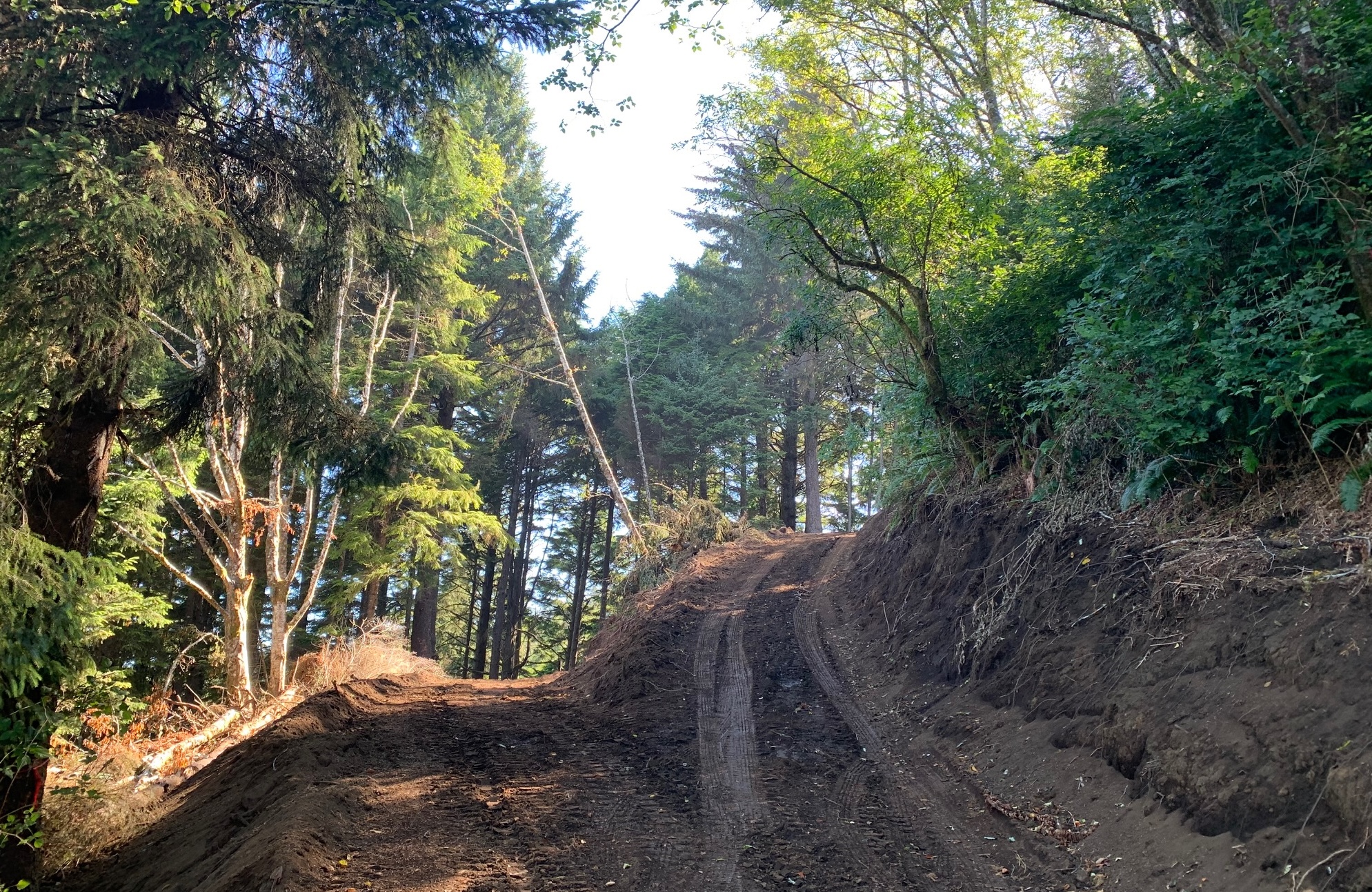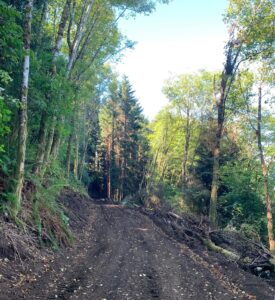
By GARRET JAROS/Lincoln Chronicle
YACHATS – When Yachats officials learned a year ago the city’s main water reservoir rests on ground so unstable it could collapse during even a moderate earthquake, they began casting about for a new site on solid ground.
After poring over maps in search of a location at the same elevation – 220 feet — as the current million-gallon reservoir to ensure compatibility with the water system’s configuration, they settled on piece of undeveloped forestland on the hillside above Sea Aire Assisted Living.

The eight-acre property is owned by Layne Morrill, a developer of affordable housing who was thwarted in using the site because of the high cost of laying in infrastructure.
That led to talks about some sort of trade with the city supplying infrastructure for housing in return for land to locate its water tank. Those talks eventually boiled down to buying the property from Morrill.
But first, with Morrill’s permission, the city carved an access road to the likely reservoir site high on the property so that engineers could determine if the ground was suitable. That report was delivered Wednesday to the Yachats city council along with a presentation by Westech Engineering manager Raymond Engel.
The main question, Engel said, and what Westech has been working on with a geotechnical consultant, is whether Yachats should move forward with buying the land to build the reservoir.
“And the answer is there isn’t an easy answer,” Engel said. “If you were hoping I would come here and say ‘This is great go for it,’ or ‘This is bad don’t do it,’ it’s not going to be that easy. And I think that ultimately there are some considerations for the city in terms of just how they really want to do it.”

The simple answer is yes, the site could be used to build a one million gallon or possibly a 1.5 million gallon reservoir to replace the main Radar Road reservoir built in 1991 along with the city’s 80-year-old 200,000-gallon reservoir just below it.
“But as we were looking at the data from the geotechnical exploration, what it will take to do what’s needed, to put that kind of tank on this particular site will be expensive,” Engel said. “It’s complex, it’s difficult and it’s expensive.”
Technicians bored two holes on the site that revealed bedrock is 25 feet below the surface. The city was thinking it would be great to build a 1.5 million gallon capacity reservoir, Engel said, “but the bigger you go with this particular site, the harder and more expensive it gets to actually fit on the site.”
Engel then used illustrations to highlight the challenges of locating just a million gallon reservoir at the location, which has a 2/1 slope, meaning for every two feet horizontally the elevation rises or falls by one foot.
The ground would need to be excavated down to where the tank – the more the better for stability – rested on rock. And because the location is nestled tight against other property lines, there would little wiggle room for access.

“The thing to notice on this is that to build that tank in that location at the right elevation (would require) a 47-foot-tall wall on the backside, built into an already relatively steeply sloping hillside,” Engel said. “Very expensive to build that wall. And it ultimately, literally, has to wrap most of the way around the tank.”
A contractor estimated the retaining wall would cost $1.4 million, which does not include the cost of excavation. Then another $600,000 to build rock piers to support the tank’s floor, $500,000 to finish the road into and around a portion of the tank, and finally $500,000 for contingency costs with additional geo-tech exploration to fine tune the design.
“So … $3 million simply to get this site ready to build a tank there,” said Engel, who added it is the unique challenges of the location that makes it so costly. “So my immediate reaction was – whoa. Can we do better?”
The engineering firm then went to the maps to look for other locations and alternatives to having one big reservoir replaced by a system of smaller tanks. But in each case, the alternatives looked prohibitive, Engel said, whether it was building on similarly steep slopes, building a reservoir east of Horizon Hill outside city limits, or the difficulty and even greater expense of having to reconfigure the city’s existing water system.
“I just keep coming back to the idea that there’s no simple solution,” Engel said.

Yachats’ water system moves through six elevation zones with the help of five pump stations. Besides the two reservoirs on Radar Road, there is a 250,000 gallon tank south of the Yachats River and 10,000 gallon tanks on Horizon Hill Road and Gimlet Lane.
In closing, Engel said the city has two real options – to go with the site on the Morrill property or discuss some of the alternatives he laid out.
After some questions from councilors about stability and fire protection with alternative options as well as whether the rest of the eight-acre Morrill property would be suitable to build housing – “That site is a challenging site for pretty much anything anybody would want to do with it,” Engel said – the council agreed to more study.
“I think we’re going to need a work session and probably a special session to discuss this,” Mayor Craig Berdie said. “ … And I think the city manager, myself, and the council president are going to have to talk about setting up some times to figure out where we’re going with this.”
In other business, the city council:
- Discussed revisions to the city’s vacation rental ordinance which include that if a license is not used to generate revenue over a two-year period it will be revoked; that a license cannot be passed down through a trust, family member or business; the license can have two people on it but they must also be on the property’s deed; and a property may be owned by a trust or business but that license must be held by a person. The revisions to the code are not yet finished but there will be two public hearings of the revisions at council meetings in October and November.
- Reviewed results from 448 responses it received from a survey about the future of fireworks in Yachats. The majority of respondents indicated they want to continue the commercial fireworks show but to crack down on illegal fireworks. Price is in discussion with the Lincoln County Sheriff’s Office about hiring extra enforcement for the city during the holiday.
- Will use the recommended model ordinance suggested by the Federal Emergency Management Agency to protect and restore fish and riparian habitats within floodplains. The ordinance requires that development does not result in a net loss of floodplain functions, including open space, water-permeable surfaces, riparian buffer zones and mature trees greater than six inches in diameter measured at breast height. Only six properties in Yachats would be affected by the ordinance if they wanted to expand the footprint of their homes.
- Garret Jaros covers the communities of Yachats, Waldport, south Lincoln County and natural resources issues for Lincoln Chronicle and can be reached at GJaros@YachatsNews.com




















When you look at the USGS data for historical seismicity from 1900 to the present day, there have been zero significant earthquakes in Yachats.